Everything You Need to Know About Camping in Joshua Tree National Park
Pitch your tent or park your RV amid the park's signature boulders and spiny plants.
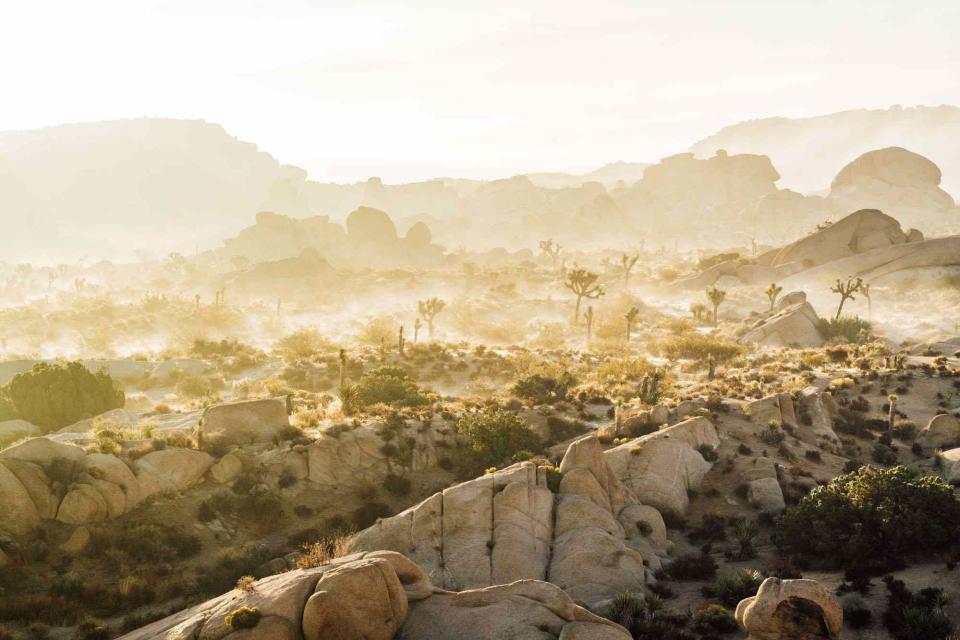
Irjaliina Paavonpera/Travel + Leisure
Fact checked by Kevin Ford
Between its expansive desert, striking boulder formations, and distinctive plant life, Joshua Tree somehow manages to feel like both an alien planet and the prototypical American landscape. Its proximity to Los Angeles makes it a favorite weekend getaway for Angelenos, but every year the park draws visitors from all around the world. Sitting at the intersection of the Mojave and Colorado deserts, Joshua Tree is a must for avid national park hikers. So, whether you're looking for a spiritual adventure or a detox from everyday life, Joshua Tree is worth a trip.
One of the best ways to experience Joshua Tree is camping within the national park. Not only does camping in Joshua Tree help you fully immerse yourself in the desert experience, it also gets you easier access to some of the best trails and bouldering rocks in the park. Here's a quick guide to camping in J-Tree, from family-forward options to the best base camp for hikers.
Related:More national parks trip ideas
The Best Joshua Tree Campgrounds
There are several things to consider when picking a campsite in or near Joshua Tree, including proximity to popular trails and landmarks. Here, we've outlined the very best J-Tree campsites for every park visitor.
Black Rock Canyon Campground
This camping spot in the northwest corner of the park is popular because it's close to a particularly dense Joshua tree grove. However, Black Rock Canyon campers should know that the most famous rock formations are farther from this campground than some of the others. There are 99 sites and 20 horse-stall sites. Campsites can accommodate both tents and RVs, and each comes with a picnic table and fire ring. Guests get access to communal restrooms, a dump station, and potable water.
White Tank Campground
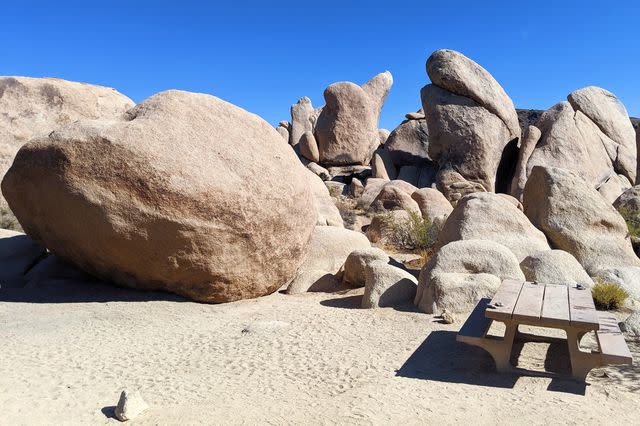
Noah Sauve/Getty Images
White Tank Campground is ideal for those who haven't made reservations, as it's all first come, first served. Tucked between the giant granite boulders, this is a nice spot for families, especially because of its proximity to the kid-friendly Arch Rock interpretive trail. Oh, and it's located in the darkest part of the park, according to the National Park Service, so leave the rain fly off your tent to stargaze in bed.
Both tents and RVs are welcome at this campground. It has vault toilets but no water, so be sure to bring plenty to drink and cook with.
Cottonwood Campground
Cottonwood Campground is a good option for short- or long-term RV stays, though tents are also welcome. Located in the southeast part of Joshua Tree National Park, it has 62 campsites laid out in two loops of 31 sites each. During the peak season (September-May), the whole campground is reservation-only. In summer, the park closes one loop and offers the other on a first-come, first-served basis. Campers can expect vault toilets, a dump station, and potable water.
Indian Cove Campground
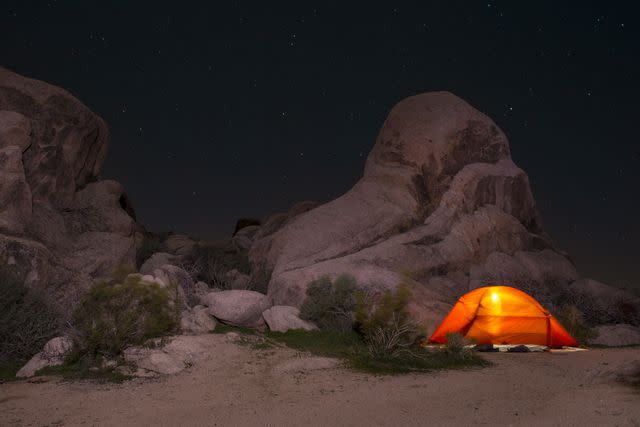
Natasha Shapiro/Aurora Photos/Getty Images
Indian Cove Campground is conveniently located off Highway 62 between Twentynine Palms and the village of Joshua Tree, neither more than a 15-minute drive away. Besides being close to essential supply points, Indian Cove is also near the rugged and boulder-packed Wonderland of Rocks backcountry hiking area. There are 101 sites, including 13 group sites, for both tents and RVs. The campground is equipped with vault toilets, but the nearest water station is two miles away.
Hidden Valley Campground
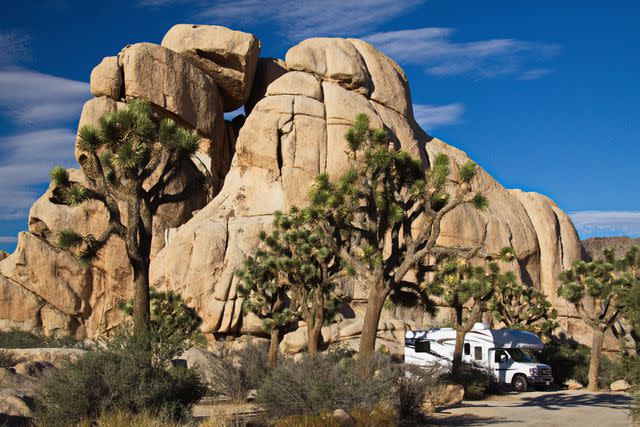
Karel Stipek/Getty Images
Hidden Valley is near the intersection of Barker Dam Road and Park Boulevard, and it makes a perfect base camp for hiking-focused campers. Its 44 sites are close to the Hidden Valley Nature Trail, Boy Scout Trail, and Keys View. All sites at Hidden Valley are first come, first served. Campers get vault toilets but no water.
Ryan Campground
Just a few miles from Hidden Valley Campground is Ryan Campground, with 31 tent and RV sites and an additional four designated equestrian sites. For hikers and horseback riders alike, this camp spot is adjacent to the California Riding and Hiking Trail. Unlike Hidden Valley, Ryan Campground is reservation-only. It has the same amenities: vault toilets, no water.
Sheep Pass Campground
In the same area as Hidden Valley and Ryan Campgrounds, Sheep Pass is a good option for groups. There are just six tent-only sites, all available by reservation only. The campground is nestled amid large boulders and right at one of the two Ryan Mountain trailheads, making it popular for both rock climbers and avid hikers. It doesn't have water, but it does have toilets.
Jumbo Rocks Campground
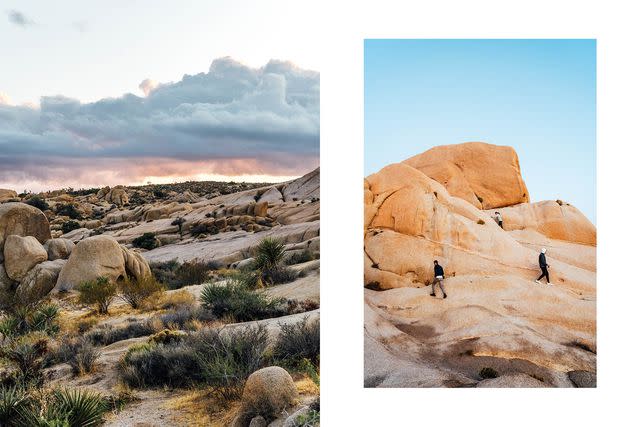
Irjaliina Paavonpera/Travel + Leisure
Jumbo Rocks is the largest campground in Joshua Tree National Park, with 124 sites accommodating both tents and RVs. The campers here get close-up views of the namesake formations and easy access to Skull Rock, a boulder with depressions that look like hollowed-out eye sockets. From September to May, reservations are required for Jumbo Rocks Campground — and beware that sites fill up fast. Like many in Joshua Tree, this campground has vault toilets but no water.
Belle Campground
Belle Campground is a great first-come, first-served option if you're unable to score a reservation at Jumbo Rocks, about five miles away. Belle's 18 sites — for tents or RVs — are in the Pinto Basin, close to Castle Rock, another popular bouldering spot. NPS notes that it's also a particularly great spot for admiring the stars in this designated Dark Sky Park.
Making Joshua Tree Camping Reservations
Joshua Tree camping reservations are hard to come by. The best plan of action is to reserve well in advance (the campgrounds that take reservations can generally be booked six months prior to your stay), or to arrive as early as possible if you're targeting a first-come, first-served alternative. If you're hoping to camp at Hidden Valley over Memorial Day Weekend, for example, you'd want to get there early on Thursday or Friday to secure a spot.
Since Belle, Hidden Valley, and White Tank campgrounds are first-come, first-served all year round, their sites fill up quickly every day during peak season. Black Rock, Indian Cove, Cottonwood, and Jumbo Rocks campgrounds take (and in some cases require) reservations.
Joshua Tree RV Camping
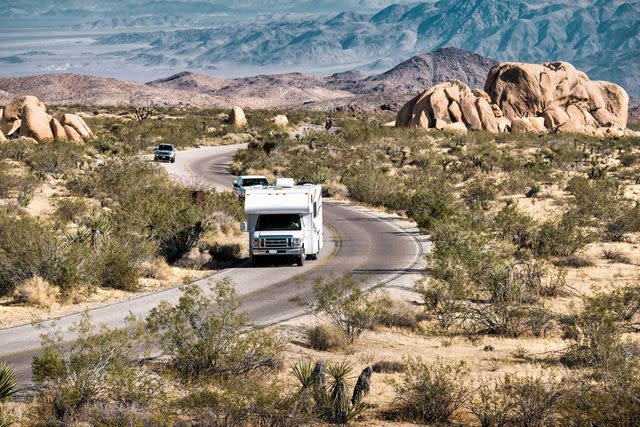
benedek/Getty Images
Except for Sheep Pass, every campground in Joshua Tree National Park allows RVs. When planning an RV adventure, it's best to book a site as soon as you've locked in your travel dates. Be sure to check that your camper will fit, as many RV-permitting campgrounds have size restrictions.
If you prefer more amenities than any available campground offers, such as water and electricity, there are a number of private RV parks in the nearby towns of Joshua Tree Village and Twentynine Palms. If you don't have your own RV and want to stay in one, check out the Airstreams at AutoCamp Joshua Tree or search Outdoorsy for more options.
The Best Time to Go Camping in Joshua Tree National Park
The best time to camp in Joshua Tree is spring — March, April, and May — when the weather has warmed but the summer heat hasn't descended on the desert. Spring is also the best time to visit because you're most likely to catch the desert wildflowers in bloom. While there may not be a full-on super bloom every year, the springtime flowers in Joshua Tree intermingled with the year-round flora and fauna is a treat to see. The temperature is also ideal in the fall for camping, hiking, and climbing — October and November are beautiful months to visit Joshua Tree. While the clear skies of summer are tempting, you'll want to hike or climb in the evening or in the early morning if visiting in June, July, August, or September to avoid the peak sun. Winter is the park's busiest season.
For more Travel & Leisure news, make sure to sign up for our newsletter!
Read the original article on Travel & Leisure.

